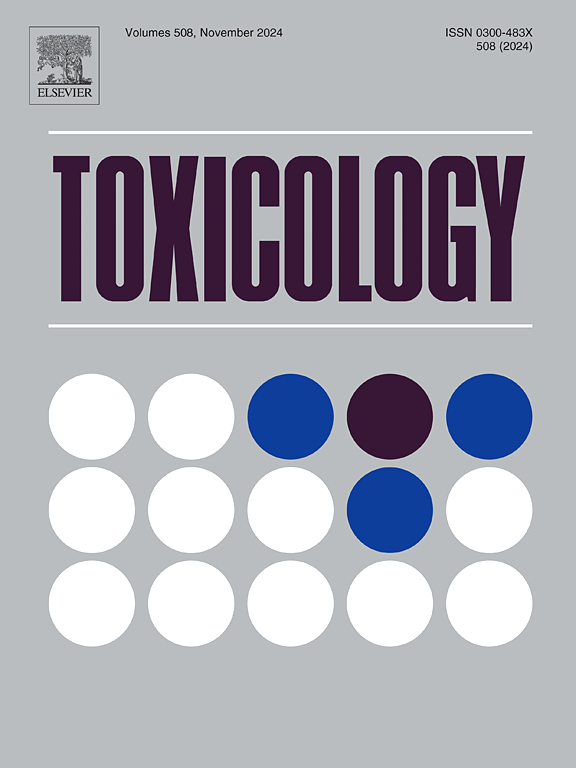预测多溴联苯醚(PBDEs)作为各种人类 CYP 酶潜在底物的可能性,并对 BDE-99 的代谢激活诱变性进行实验室测试。
IF 4.8
3区 医学
Q1 PHARMACOLOGY & PHARMACY
引用次数: 0
摘要
多溴联苯醚(PBDEs)是一种持久性有机污染物,其中的 BDE-47 可被人体细胞色素 P450s(CYPs)激活,产生染色体损伤效应。然而,其他多溴联苯醚的代谢活化和致突变性尚不清楚。本研究将 14 种具有代表性的多溴联苯醚作为几种人类 CYPs 的潜在底物进行了分子对接分析。结果表明,每一对结合的自由能均为负值,然而,不同的 CYPs 表现出的有利于底物潜在性的结合构象频率大不相同:CYP2E1、3A4 和 2B6 适合所有/大多数化合物。以 BDE-99(5 ∼ 40 μM)为模型化合物(暴露 2 个细胞周期),它在人肝癌 HepG2 细胞系中没有诱发微核,但在 C3A 细胞(源自 HepG2,但 CYPs 表达增强)中观察到阳性结果。用双酚 A(1 μM,CYPs 的诱导剂)和 CITCO(10 μM,CYP2B6 的诱导剂)预处理 HepG2 细胞会导致 BDE-99 形成微核,而 BDE-99 对 C3A 细胞的影响会被 1-氨基苯并三唑(60 μM,CYPs 的抑制剂)所消除。在表达人类 CYP2B6 的基因工程 V79 衍生细胞系中,BDE-99 会诱发微核,而在表达其他几种人类 CYPs 的 V79-Mz 及其衍生物中则呈阴性。用双酚 A 和 CITCO 预处理的 HepG2 细胞形成的微核没有中心粒蛋白 B 免疫荧光染色。最后,BDE-99 在 C3A 细胞中弱诱导 PIG-A 基因突变,而在 HepG2 细胞中则呈阴性。总之,我们的研究表明,BDE-99 可能会被人类 CYP2B6 激活,从而产生染色体断裂效应。本文章由计算机程序翻译,如有差异,请以英文原文为准。
Prediction of polybrominated diphenyl ethers (PBDEs) as potential substrates of various human CYP enzymes and laboratory test of BDE-99 for its metabolism-activated mutagenicity
Polybrominated diphenyl ethers (PBDEs) are persistent organic pollutants, of which BDE-47 could be activated by human cytochrome P450s (CYPs) for chromosome-damaging effects. However, the metabolic activation and mutagenicity of other PBDEs remain unknown. In this study, 14 representative PBDEs were analyzed by molecular docking as potential substrates for several human CYPs. The results showed negative free energies for each pair of binding, however, different CYPs demonstrated largely varied frequencies of binding conformations favoring a substrate potential: CYP2E1, 3A4, and 2B6 being suitable for all/most compounds. Using BDE-99 (5 ∼ 40 μM) as a model compound (exposing for 2 cell cycles), it did not induce micronucleus in a human hepatoma HepG2 cell line, however, positive result was observed in C3A cells (derived from HepG2 but with enhanced expression of CYPs). Pretreatment of HepG2 cells with each of bisphenol A (1 μM, inducer of CYPs) and CITCO (10 μM, inducer of CYP2B6) led to micronucleus formation by BDE-99, while the effect of BDE-99 in C3A cells was abolished by 1-aminobenzotriazole (60 μM, inhibitor of CYPs). In a V79-derived cell line genetically engineered for expressing human CYP2B6 BDE-99 induced micronucleus, while it was negative in V79-Mz and its derivatives expressing several other human CYPs. The micronuclei formed in HepG2 cells pretreated with BPA and CITCO were free of centromere protein B immunofluorescence staining. Finally, BDE-99 weakly induced PIG-A gene mutations in C3A, while negative in HepG2 cells. In conclusion, our study suggest that BDE-99 may be activated by human CYP2B6 for chromosome-breaking effects.
求助全文
通过发布文献求助,成功后即可免费获取论文全文。
去求助
来源期刊

Toxicology
医学-毒理学
CiteScore
7.80
自引率
4.40%
发文量
222
审稿时长
23 days
期刊介绍:
Toxicology is an international, peer-reviewed journal that publishes only the highest quality original scientific research and critical reviews describing hypothesis-based investigations into mechanisms of toxicity associated with exposures to xenobiotic chemicals, particularly as it relates to human health. In this respect "mechanisms" is defined on both the macro (e.g. physiological, biological, kinetic, species, sex, etc.) and molecular (genomic, transcriptomic, metabolic, etc.) scale. Emphasis is placed on findings that identify novel hazards and that can be extrapolated to exposures and mechanisms that are relevant to estimating human risk. Toxicology also publishes brief communications, personal commentaries and opinion articles, as well as concise expert reviews on contemporary topics. All research and review articles published in Toxicology are subject to rigorous peer review. Authors are asked to contact the Editor-in-Chief prior to submitting review articles or commentaries for consideration for publication in Toxicology.
 求助内容:
求助内容: 应助结果提醒方式:
应助结果提醒方式:


